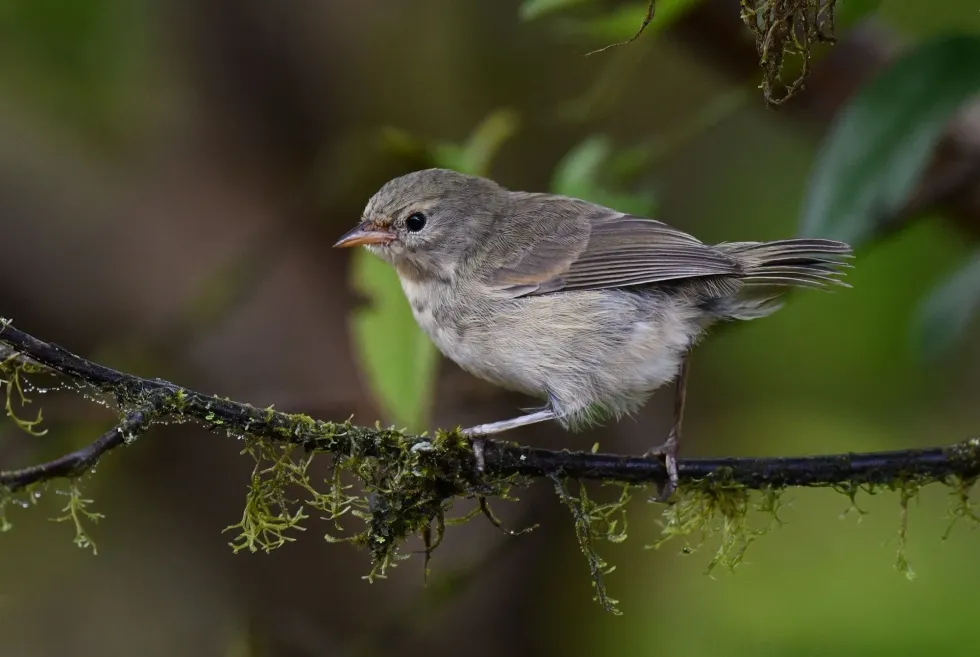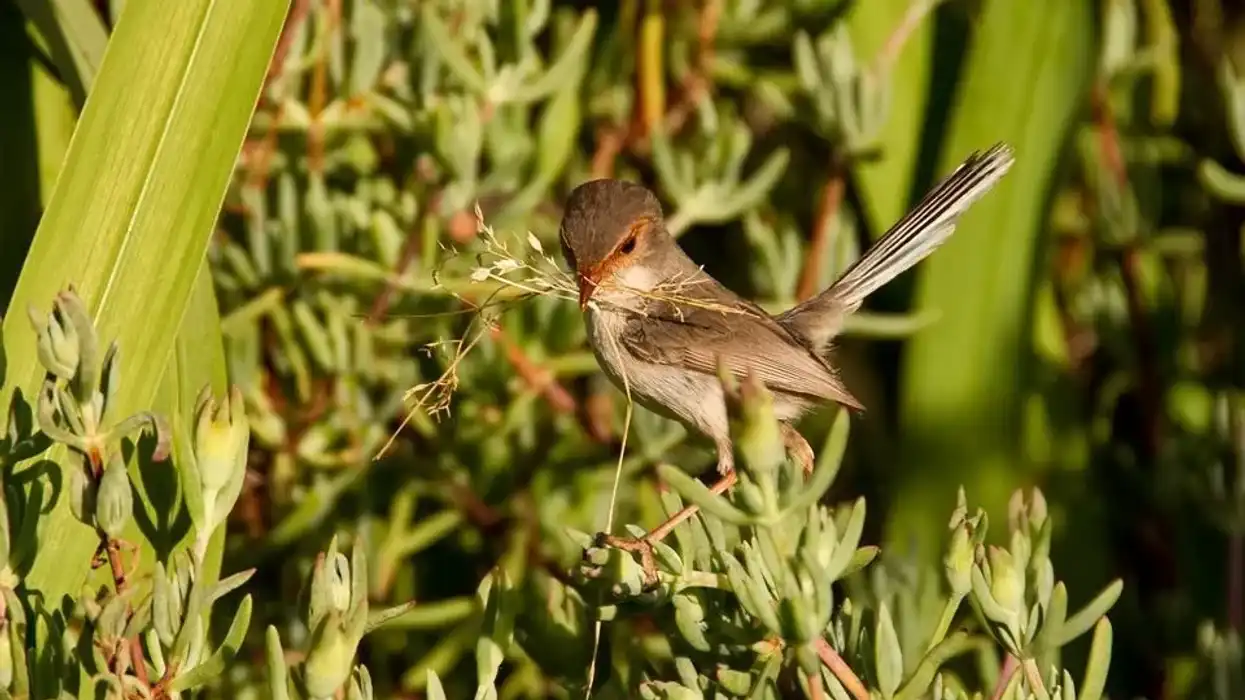The green warbler-finch (Certhidea olivacea) is one of the 18 species of finches collected by Darwin. They are called this name because their diverse beaks triggered the theory of natural selection by Charles Darwin. This species also belongs to the second-largest avian family, Thraupidae.
The appearance of the male is a sandy-olive shade with a gray head, while the female has brownish hues. These wild birds prefer breeding during hot, wet climates and the male builds the nest while the female incubates her clutch of two to four white, dark-spotted eggs for 12 days.
The nest of this species is spherical with a side entrance and made using moss, dry grass, and lichens.
This species has a large range in Ecuador, especially the Galapagos Islands including Pinzón, Santa Cruz, and Santiago. They live at an elevation of 980-2,300 ft (300-700 m) in humid highlands, and seasonally, in lowlands. Their diet consists of small insects and spiders and can catch prey with its bill and also on its wing feathers.
Finches are tiny adorable birds. To know more about them, check out some facts about the purple finch and the strawberry finch.
Green Warbler-Finch Interesting Facts
What type of animal is a green warbler-finch?
The green warbler-finch (Certhidea olivacea) is a bird species belonging to the order Passeriformes under the family Thraupidae.
What class of animal does a green warbler-finch belong to?
The green warbler-finch (Certhidea olivacea) belongs to class Aves under the genus Certhidea and the family Thraupidae.
How many green warbler-finches are there in the world?
The IUCN has not recorded the exact number of this bird species.
Where does a green warbler-finch live?
These birds are found in the Galapagos Islands of Ecuador. They can be spotted in Santiago, Santa Cruz, Fernandina, Pinzón, Rábida, Baltra, and Isabela Islands.
What is a green warbler-finch's habitat?
The green warbler-finch habitat includes humid highland forests, and occasionally, dry lowlands, depending on the season.
Who do green warbler-finches live with?
These birds are monogamous and live in pairs during the breeding season. However, they are also known to change mates or mate with multiple partners.
How long does a green warbler-finch live?
The lifespan of these birds has not been recorded.
How do they reproduce?
The green warbler-finch (Certhidea olivacea) bird species is seen breeding during the hot, wet months in the Pinzón, Santiago, Santa Cruz, Isabela, Baltra, and Isabela Islands. This bird reproduces in thsi period due to a wide range and distribution of food and vegetation.
These birds form monogamous bonding pairs or mate with many partners, but some observations report adults changing mates if previous attempts fail or if the mate goes missing.
The male builds a dome-shaped nest in small branches of shrubs and small trees, using dried grass, lichens, and mosses.
The female lays two to four eggs with a white, dark-spotted appearance and incubates them for around 12 days. The fledglings of this bird species leave their nests after two weeks.
What is their conservation status?
The IUCN has declared the conservation status Vulnerable because of the decrease in the distribution of this species due to urbanization and invasive species.
Green Warbler-Finch Fun Facts
What do green warbler-finches look like?
The green warbler-finch (Certhidea olivacea) is a small, tropical bird species with a large distribution range in Galapagos Islands. The underparts of the male are sandy olive-brown, or sometimes, white, warm buffs, with a gray head and brownish upper wing feathers and tail.
The female has lighter olive-brown and white plumage on the underparts and head. The female's upper wings have sandy hues and the juvenile resembles the appearance of the female.
Both the male and female green warbler-finch beak is long, pointy, and conical-shaped. The bill is normally yolk-yellow with a dark culmen, but during the breeding season, the bill goes through a color change and turns blackish.
Green warbler-finch birds have a pale supercilium, short tail, dark brown eyes, and black legs as well as feet. Some birds in this species have a hint of chestnut on the throat, breast, and lore.
 * Please note that this is an image of a warbler-finch, one of the 18 species collected by Darwin which is also similar to the green warbler-finch. If you have an image of a green warbler-finch, please let us know at hello@kidadl.com
* Please note that this is an image of a warbler-finch, one of the 18 species collected by Darwin which is also similar to the green warbler-finch. If you have an image of a green warbler-finch, please let us know at hello@kidadl.com
How cute are they?
This wild species has a pudgy body, small, pointy beaks, and tiny feet. Although not very colorful, these birds still have a charming appearance.
How do they communicate?
The green warbler-finch (Certhidea olivacea) communicates in short songs with few repeated notes. These birds voice a two-second high-pitched buzz that sounds like 'piut-tze zzztip' or shorter songs that sound like 'zhh-chip zhh-chip' and 'chzp-zee-chip'.
How big is a green warbler-finch?
The green warbler-finch size is around 3.9 in (10 cm), which means they are the same size as the lesser goldfinch and slightly smaller than the magnolia warbler.
How fast can a green warbler-finch fly?
The speed at which these Darwin finch flies is unknown.
How much does a green warbler-finch weigh?
The weight range of green warbler-finch (Certhidea olivacea) birds from the Galapagos Islands falls between 0.2-0.4 oz (8-12 g).
What are the male and female names of the species?
These birds do not have separate names for a male and female.
What would you call a baby Green Warbler-Finch?
The young of these birds can be called a chick or juvenile.
What do they eat?
Like most tanagers, the green warbler-finch diet is insectivorous and consists of invertebrates. It forages in humid forests and feeds on small insects like bees, hornets, sawflies, moths, beetles, dragonflies, termites, and grasshoppers.
Are they dangerous?
This bird species is not harmful.
Would they make a good pet?
This species, Certhidea olivacea, of Darwin finches are wild birds and prefer living and breeding in the humid forests.
Did you know...
Initially, when Charles Darwin collected this warbler-finch species, he thought it was a wren, and the ornithologist, John Gould, confirmed that it was a finch.
Although they differ in voice, range, appearance, and habitat, this species is closely related to the gray warbler-finch.
What is the beak of a green warbler-finch like?
These birds have a short cone-shaped bill that is broad at the base and tapers towards the end. During the breeding season, their bill gets a blackish tint. Otherwise, it's a dull yolk-orange shade with a dark culmen.
Are warbler-finches carnivorous?
Yes, these birds are carnivores. However, their diet only consists of insects, and therefore, they are placed under the insectivore category.
Here at Kidadl, we have carefully created lots of interesting family-friendly animal facts for everyone to discover! Learn more about some other birds from our hooded oriole facts and Tennessee warbler facts pages.
You can even occupy yourself at home by coloring in one of our free printable finch coloring pages.




 * Please note that this is an image of a warbler-finch, one of the 18 species collected by Darwin which is also similar to the green warbler-finch. If you have an image of a green warbler-finch, please let us know at hello@kidadl.com
* Please note that this is an image of a warbler-finch, one of the 18 species collected by Darwin which is also similar to the green warbler-finch. If you have an image of a green warbler-finch, please let us know at hello@kidadl.com



